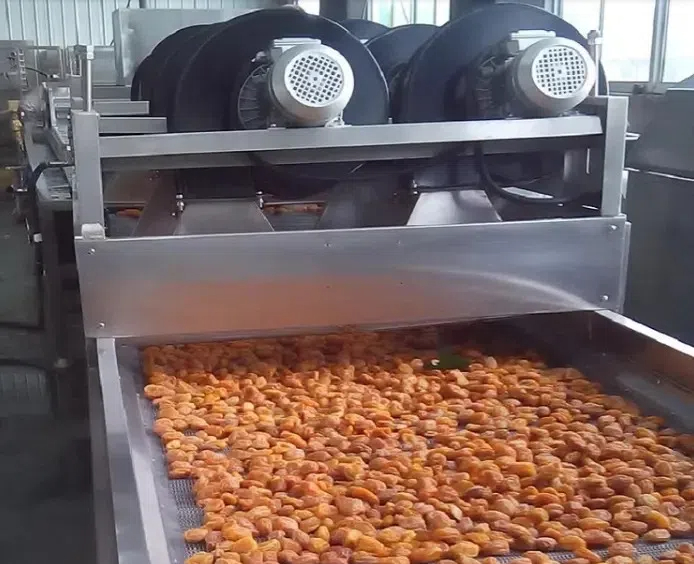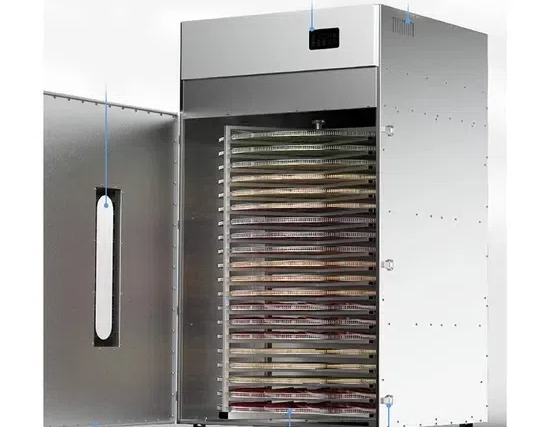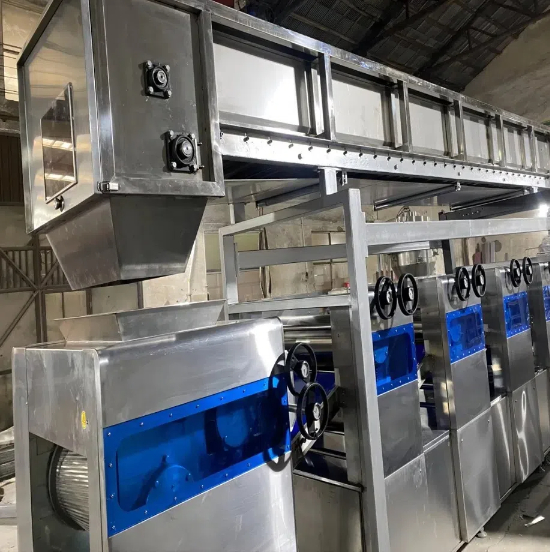
Content Menu
● Introduction
● The Basics of Food Drying
● Traditional vs. Modern Drying Methods
● Types of Food Drying Machines
● Hang Type Drying Machines: A Detailed Look
>> Key Features of Hang Type Drying Machines
>> Advantages of Hang Type Drying Machines
● Applications of Food Drying Machines
● The Technology Behind Modern Food Drying Machines
● Considerations When Choosing a Food Drying Machine
● OEM Services: Partnering with a Chinese Food Drying Machine Manufacturer
● Case Studies: Success Stories
● The Future of Food Drying
● Conclusion
● FAQ
>> 1. What is a hang type drying machine?
>> 2. What are the key benefits of using a heat pump drying machine?
>> 3. What types of food can be dried using a food drying machine?
>> 4. How do I choose the right food drying machine for my business?
>> 5. What OEM services do you offer as a food drying machine manufacturer?
● Citations:
Introduction
In today's globalized food industry, the demand for high-quality, shelf-stable food products is ever-increasing. Food drying, or dehydration, stands out as one of the oldest and most effective methods of food preservation. By reducing the moisture content of foods, drying inhibits the growth of spoilage-causing microorganisms and enzymes, thereby extending shelf life and maintaining nutritional value. As a leading Chinese food drying machine manufacturer, we provide OEM services to international brands, wholesalers, and producers, delivering state-of-the-art drying solutions tailored to meet diverse needs. This article delves into the world of food drying machines, with a special focus on hang-type drying machines, their benefits, applications, and the technology driving their innovation.

The Basics of Food Drying
Food drying is a process that removes water from food, preventing the growth of bacteria, yeasts, and molds. This not only preserves the food but also reduces its weight and volume, making it easier to store, package, and transport. The basic principles of food drying involve the application of heat to evaporate moisture and the removal of this moisture-laden air. The rate and efficiency of drying are influenced by factors such as temperature, humidity, airflow, and the surface area of the food being dried. Understanding these principles is crucial for optimizing the drying process and achieving the desired product quality.
Traditional vs. Modern Drying Methods
Historically, food drying was accomplished through natural methods such as sun drying, air drying, and smoking. While these methods are still practiced in some regions, they are highly dependent on weather conditions, labor-intensive, and often result in inconsistent product quality. Sun drying, for example, exposes food to the elements, increasing the risk of contamination from insects, dust, and microorganisms. Air drying, while less susceptible to direct contamination, is a slow process that can lead to the development of undesirable flavors and textures. Smoking, in addition to drying, imparts a distinct flavor to the food, but it also introduces potentially harmful compounds like polycyclic aromatic hydrocarbons (PAHs).
Modern food drying technologies offer several advantages over traditional methods, including:
- Controlled Environment: Precise temperature and humidity control ensure consistent and high-quality drying. This eliminates the variability associated with weather-dependent methods.
- Faster Drying Times: Advanced drying machines significantly reduce the drying time, increasing production throughput. Faster drying minimizes the risk of microbial growth and enzymatic reactions that can degrade product quality.
- Energy Efficiency: Modern machines are designed to minimize energy consumption, reducing operational costs. Heat recovery systems, insulation, and efficient air circulation contribute to energy savings.
- Improved Hygiene: Enclosed drying systems protect food from contamination, ensuring food safety. Air filtration systems and regular cleaning protocols further enhance hygiene.
Types of Food Drying Machines
Several types of food drying machines are available, each suited to different applications and product requirements:
- Cabinet Dryers: These are batch-type dryers ideal for small to medium-scale operations. They consist of an insulated cabinet with trays or racks to hold the food. Hot air is circulated through the cabinet to dry the food. Cabinet dryers are versatile and can be used for a wide range of products, including fruits, vegetables, herbs, and meats.
- Belt Dryers: Also known as continuous dryers, these machines use a conveyor belt to move food through different drying zones. They are suitable for large-scale production of granular or particulate materials. Belt dryers offer high throughput and uniform drying, making them ideal for processing large volumes of food.
- Fluid Bed Dryers: These dryers suspend food particles in a stream of hot air, providing rapid and uniform drying. They are commonly used for drying grains, seeds, and powders. Fluid bed dryers are particularly effective for heat-sensitive materials, as the rapid drying minimizes the risk of thermal degradation.
- Freeze Dryers: This method involves freezing the food and then removing the water through sublimation. Freeze-dried foods retain their original shape, flavor, and nutritional value, making them ideal for high-value products. Freeze drying is commonly used for producing instant coffee, pharmaceuticals, and specialty foods.
- Heat Pump Dryers: These energy-efficient dryers use a heat pump to extract moisture from the air, which is then recirculated. They offer precise temperature control and are suitable for a wide range of foods. Heat pump dryers are becoming increasingly popular due to their energy-saving benefits and environmental friendliness.
- Hang Type Drying Machines: Designed specifically for products that need to be hung, such as noodles, sausages, and fish. These machines ensure uniform drying and prevent deformation. Hang type dryers are essential for maintaining the shape and appearance of delicate products.
- Pan Dryers: Integrate multiple drying operations within a single unit, enabling automatic loading of wet materials and ensuring compatibility with specific product requirements. This integrated approach improves process efficiency and reduces handling costs.
Hang Type Drying Machines: A Detailed Look
Hang type drying machines are specialized dryers designed for products that require suspension during the drying process. These machines are particularly well-suited for items like:
- Noodles and Pasta: Ensures straight, uniform drying without sticking. This is crucial for maintaining the quality and appearance of long, delicate pasta shapes.
- Sausages and Processed Meats: Allows for even drying and smoking, enhancing flavor and preservation. The hanging process ensures that the entire surface of the sausage is exposed to the drying air, preventing uneven drying and spoilage.
- Fish and Seafood: Prevents deformation and maintains the product's shape. Hanging allows for proper air circulation around the fish, reducing the risk of bacterial growth and maintaining the texture of the product.
- Herbs and Spices: Preserves the natural oils and aromas. Hanging herbs and spices allows for gentle drying, which prevents the loss of volatile compounds that contribute to their flavor and aroma.
Key Features of Hang Type Drying Machines
- Stainless Steel Construction: Food-grade stainless steel (304 or 316) is used for all components in contact with food, ensuring hygiene and durability. Stainless steel is corrosion-resistant and easy to clean, making it ideal for food processing environments.
- Adjustable Temperature and Humidity: Precise control over the drying environment to optimize product quality. Adjusting temperature and humidity allows for fine-tuning the drying process to achieve the desired moisture content and texture.
- Uniform Airflow: Even distribution of air throughout the drying chamber for consistent drying. Uniform airflow prevents hot spots and ensures that all products are dried at the same rate.
- Energy Efficiency: Heat pump technology reduces energy consumption and lowers operating costs. Heat pump systems recycle heat, making them significantly more energy-efficient than traditional heating methods.
- Intelligent Control Systems: Automated operation with digital controls for easy monitoring and adjustment. Intelligent control systems allow for remote monitoring and control of the drying process, improving efficiency and reducing the need for manual intervention.
- Customizable Hangers and Racks: Designed to accommodate various product sizes and shapes. Customizable hangers and racks allow for drying a wide variety of products in the same machine.
Advantages of Hang Type Drying Machines
- Preservation of Shape: Prevents deformation and maintains the original shape of the product. This is particularly important for delicate products like noodles and fish, where maintaining the original shape is essential for market appeal.
- Uniform Drying: Ensures consistent moisture removal, preventing uneven drying and spoilage. Uniform drying minimizes the risk of mold growth and extends the shelf life of the product.
- Improved Product Quality: Enhances the appearance, texture, and flavor of the dried product. Proper drying techniques can enhance the natural flavors and aromas of the food, making it more appealing to consumers.
- Increased Throughput: Allows for continuous, high-volume drying. Continuous drying processes minimize downtime and maximize production efficiency.
- Reduced Labor Costs: Automated operation minimizes the need for manual handling. Automated systems reduce the need for manual labor, lowering operating costs and improving efficiency.

Applications of Food Drying Machines
Food drying machines are used across a wide range of industries to produce various dried products:
- Fruits and Vegetables: Dried fruits (raisins, apricots, mangoes) and vegetable chips (potatoes, carrots, beets). Dried fruits and vegetables are popular snack foods and ingredients in various culinary applications.
- Meat and Seafood: Jerky, dried fish, and other preserved meat products. Dried meats and seafood are shelf-stable and provide a convenient source of protein.
- Herbs and Spices: Dried herbs (basil, oregano, thyme) and spices (chili, paprika, cumin). Dried herbs and spices are essential ingredients in cooking and provide flavor and aroma to various dishes.
- Pet Food: Dry kibble and treats for pets. Dry pet food is convenient and provides a balanced diet for pets.
- Dairy Products: Milk powder, cheese powder, and yogurt powder. Dairy powders are used in various food products, including infant formula, baked goods, and beverages.
- Snack Foods: Extruded snacks, crackers, and pretzels. Dried snack foods are popular for their convenience and long shelf life.
The Technology Behind Modern Food Drying Machines
Modern food drying machines incorporate advanced technologies to optimize efficiency, product quality, and food safety. Some of these technologies include:
- Heat Pump Technology: Heat pumps extract moisture from the air and recirculate it, reducing energy consumption by up to 75% compared to traditional drying methods. Heat pump systems also provide precise temperature control, which is essential for drying heat-sensitive materials.
- Intelligent Control Systems: Digital controllers monitor and adjust temperature, humidity, and airflow, ensuring precise and consistent drying. Intelligent control systems can also be programmed to optimize the drying process for different types of food.
- Sensors and Monitoring: Real-time sensors track moisture levels and product temperature, allowing for dynamic adjustments to the drying process. Sensors provide valuable data that can be used to optimize the drying process and improve product quality.
- Automated Loading and Unloading: Robotic systems automate the loading and unloading of food products, reducing labor costs and minimizing the risk of contamination. Automated systems improve efficiency and reduce the need for manual labor.
- Air Filtration Systems: High-efficiency particulate air (HEPA) filters remove dust, bacteria, and other contaminants from the air, ensuring a clean drying environment. HEPA filters help maintain a hygienic environment and prevent contamination of the food.
Considerations When Choosing a Food Drying Machine
Selecting the right food drying machine is crucial for achieving optimal product quality and operational efficiency. Here are some key factors to consider:
- Product Type: Different foods require different drying conditions. Choose a machine that is specifically designed for your product. Consider the moisture content, size, and shape of the food.
- Capacity: Determine the volume of food you need to dry per batch or per day and select a machine with the appropriate capacity. Consider your current and future production needs.
- Energy Efficiency: Look for machines with heat pump technology or other energy-saving features to minimize operating costs. Evaluate the energy consumption of the machine and compare it to other models.
- Control Systems: Opt for machines with intelligent control systems that allow for precise adjustment of temperature, humidity, and airflow. Intelligent control systems can help optimize the drying process and improve product quality.
- Hygiene and Sanitation: Ensure the machine is constructed from food-grade materials and is easy to clean and sanitize. Consider the design of the machine and how easily it can be cleaned.
- Maintenance Requirements: Consider the maintenance requirements of the machine and choose a model that is easy to service and repair. Consider the availability of spare parts and technical support.
- Budget: Balance your needs and requirements with your budget to find a machine that offers the best value for your investment. Consider the total cost of ownership, including purchase price, operating costs, and maintenance costs.
OEM Services: Partnering with a Chinese Food Drying Machine Manufacturer
As a leading Chinese food drying machine manufacturer, we offer comprehensive OEM services to international brands, wholesalers, and producers. Our OEM services include:
- Custom Design and Engineering: We can design and engineer food drying machines to meet your specific requirements.
- Manufacturing and Assembly: Our state-of-the-art manufacturing facility is equipped to produce high-quality machines with short lead times.
- Quality Control: We adhere to strict quality control standards to ensure that our machines meet or exceed international standards.
- Private Labeling: We can apply your brand name and logo to our machines, allowing you to market them as your own.
- Technical Support: We provide comprehensive technical support and training to ensure that your customers can operate and maintain our machines effectively. We also offer after-sales service and maintenance contracts.
- Global Logistics: We manage the entire shipping process, ensuring your products arrive safely and on time.
Case Studies: Success Stories
- Noodle Drying: A well-known pasta brand partnered with us to develop a custom hang type drying machine. This significantly improved the quality and consistency of their dried pasta products, leading to increased sales and customer satisfaction.
- Meat Processing: A meat processing company collaborated with us to design a drying solution for their sausages. This helped them expand their product line and increase sales in international markets.
- Herbal Tea Production: An herbal tea producer worked with us to design a drying solution that preserved the delicate flavors of their herbs. This helped them improve the flavor and aroma of their dried herbs, leading to increased customer satisfaction and repeat business.
The Future of Food Drying
The food drying industry is continuously evolving, driven by technological advancements and changing consumer preferences. Some of the key trends shaping the future of food drying include:
- Sustainability: Increased focus on energy-efficient and environmentally friendly drying technologies. This includes the development of more efficient heat pump systems and the use of renewable energy sources.
- Automation: Greater adoption of automated systems to reduce labor costs and improve efficiency. This includes the use of robots for loading and unloading food products and automated control systems that can optimize the drying process.
- Smart Drying: Integration of sensors, data analytics, and machine learning to optimize the drying process. This includes the use of sensors to monitor moisture levels and product temperature in real time, and machine learning algorithms to predict optimal drying conditions.
- Nutrient Retention: Development of drying methods that preserve the nutritional value of foods. This includes the use of low-temperature drying techniques and the addition of antioxidants to prevent nutrient degradation.
- Customization: Growing demand for customized drying solutions tailored to specific product requirements. This includes the development of machines that can be configured to dry a wide variety of food products and the use of 3D printing to create custom hangers and racks.
Conclusion
Food drying machines are essential tools for preserving food, extending shelf life, and creating value-added products. Hang type drying machines, in particular, offer unique advantages for products that require suspension during drying, ensuring uniform drying, improved product quality, and increased throughput. As a leading Chinese food drying machine manufacturer, we are committed to providing innovative and reliable drying solutions to our partners worldwide. By partnering with us, you can leverage our expertise, advanced technology, and comprehensive OEM services to meet the evolving needs of the food industry and achieve success in the global market.

FAQ
1. What is a hang type drying machine?
Hang type drying machines are specialized dryers designed for products that need to be suspended during the drying process, such as noodles, sausages, and fish. These machines ensure uniform drying and prevent deformation by allowing air to circulate freely around the product.
2. What are the key benefits of using a heat pump drying machine?
Heat pump drying machines are energy-efficient and offer precise temperature control, reducing energy consumption by up to 75% compared to traditional drying methods. They are suitable for a wide range of foods and help preserve the color, flavor, and nutritional value of the dried product by using lower temperatures.
3. What types of food can be dried using a food drying machine?
Food drying machines can be used to dry a wide variety of foods, including fruits, vegetables, meats, seafood, herbs, spices, pet food, and dairy products. The specific type of machine and drying conditions will vary depending on the food being dried.
4. How do I choose the right food drying machine for my business?
When choosing a food drying machine, consider factors such as the type of product you want to dry, the capacity you need, energy efficiency, control systems, hygiene and sanitation, maintenance requirements, and your budget. It's also important to consider the long-term costs of ownership and the availability of technical support.
5. What OEM services do you offer as a food drying machine manufacturer?
As a leading Chinese food drying machine manufacturer, we offer comprehensive OEM services, including custom design and engineering, manufacturing and assembly, quality control, private labeling, technical support, global logistics, and after-sales service. We can tailor our services to meet your specific needs and requirements.
Citations:
[1] https://www.dryeratech.com/hang-type-drying-machine.html
[2] https://www.montpellier-appliances.com/tumble-dryer-settings-features-explained/
[3] https://patents.google.com/patent/CN110207480A/zh
[4] https://www.ike.cn/food-dehydrator.html
[5] https://www.iqsdirectory.com/articles/dryer/types-of-dryers.html
[6] https://patents.google.com/patent/CN201919616U/zh
[7] https://food-drying-machine.com/food-drying-equipment
[8] https://www.applianceforce.co.uk/hints-tips/16-tumble-dryers/35-different-types-of-tumble-dryers.html
[9] https://gcwgandhinagar.com/econtent/document/1588156026Unit%20V%20Types%20of%20dryers%20and%20their%20applications.pdf











